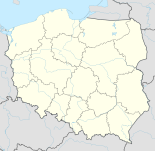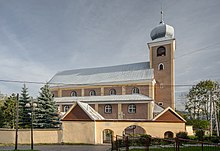Stronie Śląskie
| Stronie Śląskie | ||
|---|---|---|

|
|
|
| Basic data | ||
| State : | Poland | |
| Voivodeship : | Lower Silesia | |
| Powiat : | Kłodzko | |
| Area : | 2.49 km² | |
| Geographic location : | 50 ° 18 ' N , 16 ° 53' E | |
| Height : | 500 m npm | |
| Residents : | 5709 (Jun. 30, 2019) |
|
| Postal code : | 57-550 | |
| Telephone code : | (+48) 74 | |
| License plate : | DKL | |
| Economy and Transport | ||
| Street : | Lądek-Zdrój - Bystrzyca Kłodzka | |
| Next international airport : | Wroclaw | |
| Gmina | ||
| Gminatype: | Urban and rural municipality | |
| Gmina structure: | 15 localities localities | |
| Surface: | 146.42 km² | |
| Residents: | 7539 (June 30, 2019) |
|
| Population density : | 51 inhabitants / km² | |
| Community number ( GUS ): | 0208133 | |
| Administration (as of 2007) | ||
| Mayor : | Zbigniew Łopusiewicz | |
| Address: | ul.Kosciuszki 55 57-550 Stronie Śląskie |
|
| Website : | www.stronie.pl | |
Stronie Śląskie [ ˈstrɔɲɛ ˈɕlõscɛ ] (German Seitenberg ) is a town in the powiat Kłodzki in the Lower Silesian Voivodeship in Poland. It is located seven kilometers south of Lądek-Zdrój .
geography
Geographical location
Stronie Śląskie is located in the east of the Glatzer boiler on the Biele . It is surrounded by the Glatzer Snow Mountains , the Bielen Mountains and the Reichenstein Mountains .
Neighboring places
Neighboring towns are Strachocin and Stójków in the north, Goszów and Stary Gierałtów in the east, Młynowiec in the south-east, Bolesławów , Kletno and Stara Morawa in the south, Sienna and Janowa Góra in the south-west, Rogóżka and Czatków ( Tschihak ) in the west, and Konradów and Kzyckiety Bye in the north . To the southeast is the 1083 m high mountain Czernica ( Black Mountain ).
history
Seitenberg was first mentioned in 1346 and belonged to the Karpenstein rule in the Glatzer Land , with which it shared the history of its political and ecclesiastical affiliation. Since 1350 it was a center of iron ore mining . At the end of the 15th century there was an ironworks here; In 1505 the place had mountain jurisdiction . The mining industry perished in the Thirty Years' War .
After the Silesian Wars , Seitenberg and the County of Glatz came to Prussia in 1763 with the Peace of Hubertusburg . After the reorganization of Prussia, it belonged to the province of Silesia from 1815 and was incorporated into the district of Habelschwerdt from 1818 to 1945 .
Since the beginning of the 18th century, glass manufacturing was one of the main livelihoods of the population. In addition to the existing quartz sand , the abundance of forests in the surrounding mountains played a decisive role. In the neighboring Schreckendorf , the Oranienhütte Franz Losky glass factory started operations in 1864 , producing world-famous products and employing 700 people at the beginning of the 20th century. There was also a marble quarry in Seitenberg, the stones of which were used, among other things, for the construction of the Kamenz Castle.
With the commissioning of the Bieletalbahn from Glatz via Bad Landeck to Seitenberg in 1897 an economic upswing followed. As a result of the Second World War , Seitenberg fell to Poland in 1945, like almost all of Silesia, and was renamed Stronie Śląskie . The German population was expelled. Some of the new residents were displaced from eastern Poland , which had fallen to the Soviet Union .
In 1960 Stronie Śląskie became a town-like settlement. With the construction of many houses and apartment blocks, it has grown together with Goszów and Strachocin and is now an industrial center for glass production and wood processing. In addition, Stronie Śląskie, which was promoted to town in 1967, developed into a resort. 1975-1998 it belonged to the Wałbrzych Voivodeship (German Waldenburg ). In 1977 and 1997 considerable damage was caused by floods.
Seitenberg rule
In order to cover the costs of the Turkish wars , Emperor Leopold I sold numerous chamber villages in the Habelschwerdter and Landecker districts to the Glatz governor Michael Wenzel von Althann , who already owned the dominions of Mittelwalde , Wölfelsdorf and Schönfeld .
He formed the allodial rule Seitenberg from the chamber villages in the Landecker district . The villages: Seitenberg, Wilhelmsthal , Johannesberg , Kamnitz , Klessengrund , Martinsberg ( until 1789 ), Mühlbach , Wolmsdorf ( until 1789 ), Winkeldorf ( until 1789 ), Heudorf , Altmohrau , Neumohrau , Gompersdorf , Altgersdorf , Neugersdorf , Weißwasser ( until 1789) and Bielendorf . In 1740, the imperial field marshal Georg Olivier von Wallis added the village of Schreckendorf to the Seitenberg lordship, which he had previously acquired from the Bohemian Chamber .
Owner of the Seitenberg estate
After Michael Wenzel von Althann died in 1686, Seitenberg's reign was inherited by his widow Anna Maria von Aspremont. After her death in 1723, the rule fell to her younger son Michael Friedrich von Althann . He was Bishop of Waitzen and sold the Seitenberg estate to Field Marshal Georg Olivier von Wallis in 1733. His son Stephan Olivier von Wallis sold the goods left behind by his father in 1783 to Friedrich Wilhelm Graf von Schlabrendorf on Hassitz und Stolz. He sold the Seitenberg rule in 1789 to the royal judiciary Franz Bernhard von Mutius on Altwasser and Gellenau . From 1838 the rule Seitenberg was owned by Marianne Princess of the Netherlands , who was married to Prince Albrecht of Prussia . The last owner was Prince Friedrich Heinrich of Prussia. The 207 km² entails of the Dutch House of Orange-Nassau in Lower Silesia comprised the lords of Kamenz , Schnallenstein and Seitenberg as well as the Schönau manor . With 130 km² Seitenberg was the largest dominion.
Attractions
- The parish church of St. Maternus ( Kościół pw św. Maternusa ), located on a hill, was first mentioned in 1264 and built in the Baroque style in 1732 as a foundation by Cardinal Michael Friedrich von Althann . The tower was built in 1811-1816. The ceiling painting was created by Landeck painter Wilhelm Reinsch, the figures of saints, the guardian angel, the Pietà and the Way of the Cross by Landeck sculptor Franz Thamm around 1880. The crystal chandelier was a gift from the glassmakers and glass cutters of the Oranienhütte.
- The simple castle, which was the seat of the Seitenberg rule until 1945, is located on a small park.
- The former Protestant Christ Church from 1915, the construction costs of which were paid for from the legacy of Prince Albrecht of Prussia , now serves as a cemetery chapel.
- The plague column dates from 1672. The fine bas-reliefs are richly decorated: Carrying the Cross, Crucifixion , Holy Trinity , St. Joseph , Ecce Homo , Justitia , Immaculata , St. Maternus and St. Augustine .
- The octagonal St. Onuphrius Chapel, which was left to decay, was donated by Count Johann Olivier von Wallis.
Personalities
- Franz Losky (1811–1870), glassmaker and glass industrialist
Population development
| year | 1825 | 1905 | 1939 | 1961 | 1970 | 2002 |
|---|---|---|---|---|---|---|
| population | 566 | 1,098 | 973 | 5,081 | 5,450 | 6,260 |
Gmina
The urban and rural municipality Gmina Stronie Śląskie covers an area of 145 km² with 8012 inhabitants. These include the following locations:
- Bielice ( Bielendorf )
- Bolesławów ( Wilhelmsthal )
- Goszów ( Gompersdorf )
- Janowa Góra ( Johannesberg )
- Kamienica ( Kamnitz )
- Kletno ( Klessengrund )
- Młynowiec ( Mühlbach )
- Nowa Morawa ( New Mohrau )
- Nowy Gierałtów ( New Gersdorf )
- Sienna ( Heudorf )
- Stara Morawa ( Alt Mohrau )
- Stary Gierałtów ( Alt Gersdorf )
- Strachocin ( horror village )
- Stronie Śląskie ( Seitenberg ) - town
- Stronie Wieś ( Seitenberg ) - village
Twin cities
- Staré Město pod Sněžníkem , Czech Republic
- La Machine , France
- Chodzież , Poland
- Dippoldiswalde , Germany
- Szikszó , Hungary
literature
- Dehio Handbook of Art Monuments in Poland. Silesia. Deutscher Kunstverlag, Munich et al. 2005, ISBN 3-422-03109-X , p. 876.
- Peter Güttler: The Glatzer Land. A travel guide to the landscape, art and culture of the Kłodzko Mountains / Ziemia Kłodzka in Silesia. Aktion West-Ost eV, Düsseldorf 1995, ISBN 3-928508-03-2 , pp. 103-104.
- Joseph Kögler : The chronicles of the county Glatz. Revised and edited by Dieter Pohl . Volume 1: The town and parish chronicles of Lewin - Mittelwalde - Wünschelburg - Neurode - Wilhelmsthal. Pohl, Modautal 1993, ISBN 3-927830-06-2 , pp. 189–190 ( historical sources of the county of Glatz. Series A: Ortsgeschichte NF 1).
Web links
Individual evidence
- ↑ a b population. Size and Structure by Territorial Division. As of June 30, 2019. Główny Urząd Statystyczny (GUS) (PDF files; 0.99 MiB), accessed December 24, 2019 .
- ^ Arno Herzig , Małgorzata Ruchniewicz : History of the Glatzer country . Hamburg-Wrocław 2006. ISBN 3-934632-12-2 , pp. 329-330






